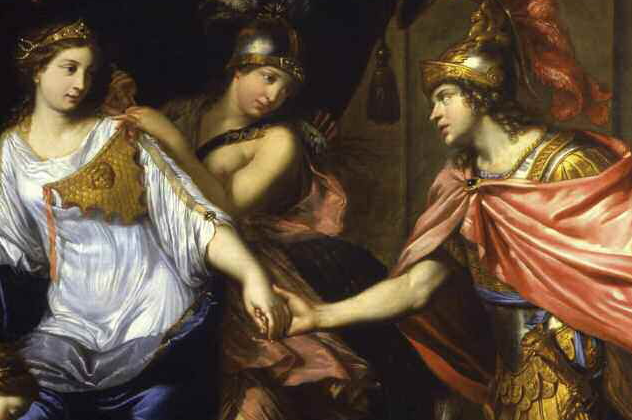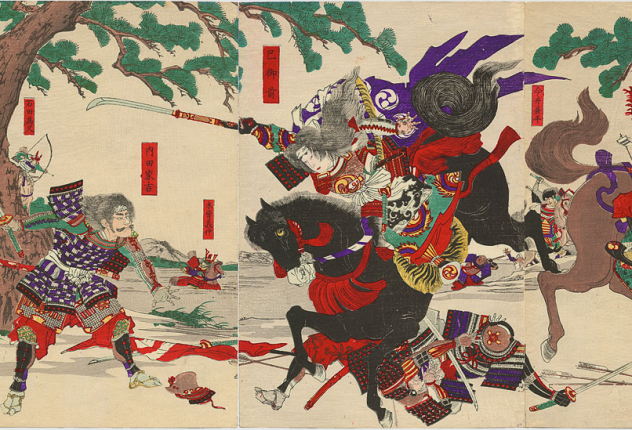 Animals
Animals  Animals
Animals  Weird Stuff
Weird Stuff 10 Weird Things People Used to Do at New Year’s
 Our World
Our World 10 Archaeological Discoveries of 2025 That Refined History
 Weird Stuff
Weird Stuff 10 Fascinating Facts You Might Not Know About Snow
 Miscellaneous
Miscellaneous Top 10 Things Crypto Was Supposed to Change & What Actually Did
 History
History 10 Huge Historical Events That Happened on Christmas Eve
 Music
Music 10 Surprising Origin Stories of Your Favorite Holiday Songs
 History
History 10 Less Than Jolly Events That Occurred on December 25
 Weird Stuff
Weird Stuff 10 Funny Ways That Researchers Overthink Christmas
 Politics
Politics 10 Political Scandals That Sent Crowds Into the Streets
 Animals
Animals 10 Species That Refused to Go Extinct
 Weird Stuff
Weird Stuff 10 Weird Things People Used to Do at New Year’s
 Our World
Our World 10 Archaeological Discoveries of 2025 That Refined History
Who's Behind Listverse?

Jamie Frater
Head Editor
Jamie founded Listverse due to an insatiable desire to share fascinating, obscure, and bizarre facts. He has been a guest speaker on numerous national radio and television stations and is a five time published author.
More About Us Weird Stuff
Weird Stuff 10 Fascinating Facts You Might Not Know About Snow
 Miscellaneous
Miscellaneous Top 10 Things Crypto Was Supposed to Change & What Actually Did
 History
History 10 Huge Historical Events That Happened on Christmas Eve
 Music
Music 10 Surprising Origin Stories of Your Favorite Holiday Songs
 History
History 10 Less Than Jolly Events That Occurred on December 25
 Weird Stuff
Weird Stuff 10 Funny Ways That Researchers Overthink Christmas
 Politics
Politics 10 Political Scandals That Sent Crowds Into the Streets
10 Intriguing Stories About The Legendary Amazons
The Greek myths about societies of warrior women called Amazons have fascinated and mystified generations of scholars. Amazon fighting skills equaled that of Greek heroes. Hercules fought to obtain the girdle of Hippolyte, queen of the Amazons. Theseus attacked them and eventually married Antiope. Achilles battled and killed Penthesilea, realizing too late that he was in love with her. For centuries, legends such as these were treated as fanciful in every detail. However, in recent years, historians have come to believe that the core of the myths may be based on historical fact.
10 The Origin Of The Name

A lot of unsubstantiated legends have accumulated over the centuries regarding the fierce female warriors whom the ancient Greeks held in awe. Chief among them is the provenance of the name “Amazon” itself.
It was long supposed that it came from the Greek prefix a (“without”) and mazan, which sounds like the word for “breast” (mastos). “Amazon” therefore allegedly meant “without breast,” and it was thought that these women warriors cut off one breast so it wouldn’t get in the way of firing an arrow or throwing a spear. This was how the historian Hellanikos explained the term in the fifth century BC, but this theory is plainly ridiculous. We don’t see modern female archers having trouble with their boobs. Besides, no Greek depiction of an Amazon in art ever features a missing breast.
Many etymological suggestions have been put forward, and one in particular has found much scholarly support in the 20th century. It was proposed in 1912 that “Amazon” was derived from the Old Iranian ha-mazan (warrior). Since archaeology has discovered that Iranian peoples called Sauromatians (or Sarmatians) and Scythians had female warriors, the theory makes sense. However, the Greeks were already using the word before they even heard of these steppe dwellers, so it appears that we must look elsewhere for its true origins. The mystery remains.
9 Figment Of Greek Imagination?

Until recently, Amazons were regarded by most historians as beings of myth. In 1861, Swiss classical scholar Johann Jakob Bachofen first put forward the controversial thesis that the Amazons were indeed historical figures. In his theory, Bachofen said that human society began as a matriarchy, ruled by priestesses and worshiping the Earth-Mother. Only at the dawn of civilization did patriarchy emerge.
Bachofen influenced artists such as Richard Wagner, whose Ring Cycle extols Brunnhilde and the Valkyries, and thinkers such as Friedrich Engels. Engels and his fellow Marxists envisioned the primeval rule of women as a peaceful, classless utopia where property didn’t exist. Engels lamented, “The overthrow of mother-right was the world historical defeat of the female sex. The man took command in the home also; the woman was degraded and reduced to servitude; she became the slave of his lust and a mere instrument for the production of children.”
However, there simply was no hard evidence for Bachofen’s thesis. In the 20th century, more bizarre explanations for the mystery of the Amazons cropped up. One school of thought claimed that the Amazons were actually beardless men in outlandish dress (probably Hittites), who were mistaken for women from a distance by the Greeks. To those steeped in Freudian and Jungian psychology, Amazons were expressions of Athenian male neuroses. Women sitting on horses (a phallic symbol) and dying violent deaths were signs of unresolved sexual conflict.
These notions were difficult to either corroborate or refute. But in the late 1980s, archaeological digs provided the first clues that the Greeks may have been relating history after all.
8 Evidence From Archaeology

Many Greek myths located the homeland of the Amazons in an eastern region called Scythia, which rings the Caspian Sea and embraces modern-day Kazakhstan. Herodotus describes the Scythians as farmers with a fairly advanced civilization for the time. He also writes of their intermarriage with warlike women, as well as the custom forbidding a young woman to marry until she has killed a male enemy in a sacred rite. This union of Scythians and Amazons produced the Sauromatian people.
Later scholars took Herodotus’s account with a grain of salt, until archaeological expeditions began to uncover graves of women with weapons and battle scars. Intriguingly, DNA evidence has indicated that 20–30 percent of burials in the steppes around the Black Sea were of warrior women.
The items discovered in the women’s graves included armor, bronze arrowheads, daggers, swords, and horse harnesses—things not normally associated with women. The artifacts showed signs of being used, ruling out a mere symbolic or ritualistic motive for their inclusion. They weren’t hunting tools, either; these tribes were cattle-breeders, not hunters. The shorter handles of the weapons show that they were actually made for and used by women, who generally have smaller physiques.
Remnants of skin also yielded war tattoos, substantiating Herodotus’s claim that the warriors made a special tattoo to record their kills. The bowed leg bones of one girl were a clue to her life on horseback. An arrowhead in the body cavity of another woman pointed to death in battle.
While many similar burial sites lay far to the west, too remote for contact with the ancient Greeks, archaeologists have proven that tribes of fierce female warriors were more common on the Eurasian plain than was previously thought.
7 The Lesbian Myth

Ancient stories depict the Amazons as unfeminine man-haters who had sex with males only to perpetuate their race. They were alleged to kill their male offspring and take captive males as slaves. Yet, there is also contradictory testimony portraying them as good mothers who sent their baby boys to the families of their fathers to be taken care of. Archaeological digs have never come upon communities consisting exclusively of females.
Apparently, Amazons did indeed enjoy sex with men. We have already seen that Amazons took Scythian men as husbands and generated the Sauromatians. Herodotus’s account of their first encounter offers a glimpse into their sexuality.
A group of Amazons from Themiscyra who were captured by a Greek force successfully killed their captors and escaped from their prison ship. Landing on the Scythian-occupied shores of the Black Sea, they began marauding the countryside to steal horses and other goods. When the Scythians learned that the invaders were women, they plotted to seduce them. A stray Amazon was ambushed by a Scythian one day, and the girl readily surrendered to sex with the man. She agreed to bring along more of her friends if the man would do the same. Before long, what began as a series of blind dates resulted in the fusion of the two peoples.
We do not know how true this story is, but it does show that the development of the Amazon myth made them more heterosexual than lesbian. Nevertheless, the image of an independent, brave, and strong warrior woman who subverted traditional gender roles appealed to the lesbian and feminist movements in the 1970s. American author Natalie Clifford Barney (who herself is nicknamed “the Amazon”) was the first to openly associate Amazons with lesbianism. The lesbian Amazon is actually a 20th-century myth.
6 Beauty Secrets

We tend to visualize Amazons as rough and unfeminine, with little interest in how they looked as they roamed the steppes. Herodotus, however, said that the Scythians, both men and women, were as concerned with grooming and beauty as anyone.
Herodotus described a Scythian sauna: Bathing was a very important purification ritual for the tribe as it prepared for funerals in the spring. First, the Scythians washed their heads with soap and water. Then, they entered a tepee-like booth constructed of stakes and woolen felt. Inside, they tossed cannabis seeds onto red-hot stones, and the resulting steam cleansed their bodies, in addition to getting them high. In support of Herodotus was a Scythian burial mound discovered in the Caucasus in 2013. The site yielded gold vessels with the residue of opium and cannabis. Archaeologists think that the opium was drunk as part of a concoction while the cannabis smoke wafted nearby.
Herodotus also described how the women prepared a beauty mask. The Amazons pounded a paste of cypress, cedar, and frankincense and mixed it with a little water. When the consistency had turned thick and smooth, the women applied it to their faces and bodies before bedtime. They woke up next morning with clean, glossy, and sweet-smelling skin. The same ingredients are used today in perfumes, cosmetics, and pharmaceuticals. Cedar and cypress are antiseptics and astringents, while frankincense can be found in beauty products that claim to rejuvenate aging skin.
Scythian graves also revealed what the women used for makeup. Boxes have been unearthed containing colorants such as ochre, cinnabar, black carbon, and white chalk. One cosmetics bag was accompanied by a horsehair face brush, a bronze mirror, and a piece of eyeliner pen filled with deep blue-green powder.
Amazons also protected their skin from the extreme temperatures of the steppes by applying cosmetic fat-based unguents. One ointment contained wild cabbage juice, which stimulated circulation and warmed the skin. It also brought relief from the arthritic pain that resulted from spending hours on horseback.
5 Alexander And Thalestris

Greek narratives placed the mythic Amazons in the distant past, usually before or during the Trojan War, or 500 years before their first mention by Homer. The stories no doubt fascinated the young conqueror, Alexander of Macedon. In his campaigns to subjugate the East, Alexander brushed the traditional homeland of the Amazons, and though it was believed that Amazons no longer existed at the time, Alexander hoped to see one for himself.
Alexander asked Pharasmanes, king of Chorasmia, if there were any Amazons in his part of the world. The king replied, “Oh yes, lots; in fact, they are my neighbors.” Soon, one of the horseback-riding, weapon-wielding girls was escorted into Alexander’s presence. The story of this historical meeting grew with each retelling, and the quite plain and ordinary girl was transformed by legend into Thalestris, queen of the Amazons.
In the legend, Thalestris came to Alexander with an unusual request—she wanted the conqueror to father her child. It was an experiment in eugenics, as Thalestris hoped to breed a race of warriors as strong and intelligent as Alexander. Alexander gave his army a 13-day furlough while he and Thalestris got down to the enjoyable business of making a super baby. It was agreed that if the baby was a girl, Thalestris would raise her; if it was a boy, he would be returned to Alexander in accordance with Amazon custom. Satisfied that she had been impregnated, Thalestris then returned home, and Alexander turned his attention to the Parthian campaign.
Rumors about Alexander and the Queen of the Amazons began to circulate soon after. Onesicritus, Alexander’s naval commander, was one of those who helped fuel the rumor. When recounting the episode to King Lysimachus of Thrace, who was on the campaign with Alexander, he was stopped short by the king, who asked, “And where was I, then?” Alexander’s biographer Arrian was skeptical. Also, Plutarch cited a letter from Alexander himself denying the story. The letter did mention that a Scythian chieftain offered his daughter to Alexander in marriage, but he graciously refused.
4 Warrior Queens Of The Middle East

Warrior women were not confined to the Eurasian plains. Elsewhere in the ancient world, we find accounts similar to the Greek narratives. Neo-Assyrian records from the eighth century BC speak of queens of Qedar who ruled over nomadic Arab and Semitic tribes ranging from Syria to the Nile. One of them, Zabibi, may have been part of a dynasty that included the legendary Queen of Sheba, whose visit to King Solomon is recorded in the Bible.
Zabibi was a vassal of the Assyrain king Tiglath Pileser III. Her successor, Queen Samsi, threw off the yoke of tribute and, with the ruler of Damascus, began a rebellion against Tiglath Pileser in 732 BC. Male Arab warriors were joined by females in the decisive battle near Mt. Saquuri. Unfortunately, Samsi and her Amazons were defeated, and the queen fled into the desert. Samsi ultimately surrendered, and Tiglath Pileser allowed her to remain queen of Qedar until 728 BC. Samsi’s successor, Queen Yatie, joined an alliance of Chaldeans, Elamites, and Arameans to wrest control of Babylon from King Sennacherib of Assyria in 703 BC.
In a world where kings held absolute sway over governance, the mention of queens taking on a male-dominated role is intriguing. It lends credence to the Biblical tale of the Queen of Sheba. Sheba herself may be the “Saba,” whose tributes Tiglath Pileser received. However, after Queen Te’elkhunu in 691 BC, politically active Arab queens disappear from the historical record.
By the first century AD, the Qedarites were no more, but the third century saw the rise of a warrior queen named Zenobia, who defied the Romans. Later medieval Arabic romances were populated by warlike females, among them a woman named “Wolf.”
3 The Elephants Of Samos

Elephants are not native to the Greek isle of Samos, so we can imagine how ancient Greeks were baffled by the skeletal remains of what appeared to be gigantic pachyderms in its soil. The mystery was debated and recorded by Plutarch around AD 100 in his Greek Questions, a compendium of ancient curiosities and marvels.
Travelers to Samos could visit two sites where they could view the giant bones: Panaima (“blood-soaked field”) and Phloion (“crust of the Earth”). Plutarch cited folklore stating that the red earth from which Panaima got its name became that way when it was soaked with the blood of warriors killed in a terrific battle between the wine god Dionysus and the Amazons. In the Hellenistic myth, Dionysus marched to Greece from India with a host of war elephants. Dionysus attacked the Amazon stronghold of Ephesus, on the coast of Asia Minor across from Samos. When the women fled to the isle, Dionysus and his elephants took off in pursuit and defeated the Amazons in a mighty struggle there.
There was a belief that people of the mythic age, including Amazons, were of enormous size. Many identified the massive bones as belonging to the fallen Amazons, but many also recognized their structure and believed that they were the remains of Dionysus’s war elephants. Greeks had been familiar with elephants ever since Alexander the Great encountered them in India, though their presence in Samos was a mystery.
The latter explanation came close to the truth. The fossils in Samos were actually prehistoric mastodons. The fossil beds were first investigated by scientists in 1870. They have since concluded that Miocene mastodons roamed the area eight million years ago.
2 Female Gladiators

The Romans were always fascinated by the fighting Amazons of myth. Julius Caesar defended his manhood by comparing himself with warrior queens. A statue of an Amazon astride a rearing horse was plundered by a Roman connoisseur in Ephesus. The Amazon depicted, called Euknemon (Greek for “beautiful knees”), was nicknamed “Lovely Legs” by the Romans for her sensuous limbs. Nero developed such a crush on the statue that he confiscated Lovely Legs from her owner and had her paraded around by porters. Nero also included in his retinue concubines attired in Amazon costume, complete with shields and battle axes.
The emperor Commodus sealed letters with a signet ring depicting an Amazon. He renamed December “Amazonius” and called his girlfriend “Marcia” (“warlike”) after Mars, the god of war, and dressed her up as an Amazon.
There is also evidence that the Romans were witnesses to the fighting skills of actual women warriors. A 2,000-year-old bronze statuette of a female gladiator in the Museum of Art and Industry in Hamburg, only the second one known, tells us that women participated in deadly combat in the arena.
The image is that of a woman, breasts exposed and wearing only a loincloth, her left hand holding a sica (a short, curved sword) in what appears to be a victory pose. Her use of the sica identifies her as a thraex, a gladiator who sported a plumed helmet, small shield, and metal leg guards. After a battle, gladiators removed their helmets and dropped their shields, explaining why the woman doesn’t have either of these items.
Another notable discovery was that of a female gladiator’s tomb in London. The presence of expensive oil lamps and evidence of a large banquet indicates that this woman was a revered fighter—no small accomplishment in a society where women were not regarded as equals of men.
Rules of gladiatorial combat required men and women to fight bare-chested, so we can be sure that the erotic attraction of topless women gladiators drew in large crowds of males. Female gladiators even fought in Rome itself. Emperor Domitian watched these fighters battle it out at night by torchlight. Re-enactments of battles between Greeks and Amazons employed female gladiators. In AD 200, Septimius Severus finally banned female combat.
1 Female Samurai

Just as the Greeks had their myths of Amazons, modern anime, manga, and comic books paint a fantasy world where sword-wielding women are commonplace.
In medieval Japan, fantasy met reality. Take, for example, Tomoe Gozen, a female samurai whose exploits in the 12th-century civil wars are celebrated in songs and a popular play. In fact, women born into the samurai class were considered samurai whether they became warriors or not. They practiced the loyalty and honor as prescribed by the Bushido code. They might even carry the scythe-like naginata and have daggers on their belts. They shared their men’s defeats to the point of exile and death.
The beautiful Tomoe was the concubine (or one of the wives) of Lord Kiso no Yoshinaka. During the Genpei Civil War, Tomoe rode out to battle in armor, armed with a bow and a sword. Her skill and bravery impressed Lord Kiso, who made her the leading commander of his forces. In 1181, at the battle of Yokotagawara, Tomoe defeated the enemy and took the heads of seven cavalrymen as trophies. Two years later, she led Lord Kiso’s cavalry into another victory. Even in defeat, Tomoe was surprisingly hard to kill. She once led 300 men against 6,000 of the enemy; Tomoe was among only five survivors of Lord Kiso’s force.
After the war, Lord Kiso had to confront another rival, his cousin Yoritomo. In her final battle, Tomoe singled out the most worthy opponent among the troop of enemy horsemen, engaged him in single combat, and beheaded him. It was all for naught, however, as Lord Kiso was afterward killed and was himself decapitated.
No one knows what became of Tomoe after this encounter. It is speculated that she was eventually captured, while others say she retired as a Buddhist nun and lived to be 91. A more melodramatic account had her avenging Lord Kiso and retrieving his severed head, after which she drowned herself at sea, the head still in her hands.
Larry is a freelance writer whose main interest is history.








